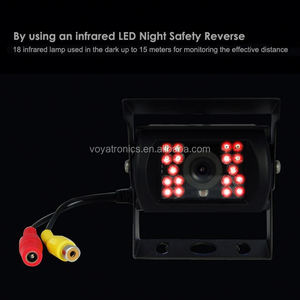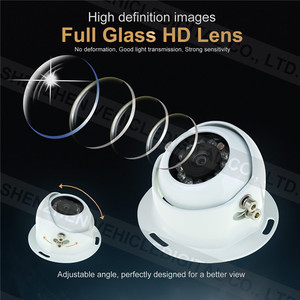(40 products available)





















































































































































































A Charge-coupled device (CCD) refers to an imaging sensor built to capture light photons and convert them into electrical signals. A CCD camera can capture high-quality images based on these signals. The CCD 420 TVL camera falls within this category and is often used in surveillance systems. There are different types of CCD cameras, such as the new advanced progressive scan and interline cameras, that should be familiar to business buyers.
A CCTV camera with a 420 TVL CCD shows a decent level of detail, and the specifications of the CCD impact its performance in low-light settings.
Equipped with a 1/3 inch imager and a 420 TVL resolution, the TV line specification shows how well-formed the imaging pixels in a CCTV camera are. Other cameras have a 420 TVL CCD but with different imager sizes and TVL lines, so they will work better at certain distances.
The powerful feature of a 420 TVL CCD camera is the ability to work in low-light environments. Some models only need .1 lux to function well, while others need .05 lux or less. Cameras that work at .05 lux or even lower are better in complete darkness. A CCD camera example working in near black condition is one that works at just .0005 lux. To view an image in low light, a camera must have an infrared (IR) illuminator or starlight technology.
For a 420 TVL CCD camera to record clear images, the shutter speed must reach at least 1/50 to capture details of moving objects. With some models having a shutter speed of 1/50 to 1/100, others can reach up to 1/100, 1/200, or even higher. The higher the shutter speed, the better the camera can capture fast-moving objects and act against blurring.
The lens size in a 420 CCD camera determines the viewing angle. A camera with a 3.6 mm lens will give a wider horizontal view of 90 degrees. Other types will get a more extended view, while some will be zoomed-in or more magnified.
Many 420 TVL CCD cameras use a simple digital encoding method called MJPEG. This format compresses data as the camera transmits the video images over the internet or through a cable for viewing on monitors, recorders, and laptops. Some record video at 30 frames per second (fps), while others record at 15 fps or less.
Like any camera, a CCD camera needs some maintenance to work well and give a clear image. The first task is to read the user manual and follow all instructions on installation and care. Because these cameras are in public places, they can get vandalized or damaged. An additional necessary step is to make the camera casing or housing tamper-proof so that no one can damage or spoil the camera.
Surveillance camera cleaning is an essential maintenance routine. Service providers or the users of the camera can clean the housing or casing with a gentle cleaning agent and soft microfiber cloth. This will remove dust and debris blocking the camera lens and fogging the image.
Occasionally, the camera firmware or software should be updated if the camera has it. Doing this will improve performance and fix known issues with the device.
A 420TVL CCTV camera can be used in various applications that require surveillance and monitoring. The following are some typical usage scenarios where a 420 TVL CDD camera may come useful:
Although people predominantly use the CCTV system in homes and workspaces, business buyers can focus on some of the less trendy features when choosing CCD CCTV cameras.
Focus on the application area.
Business buyers should ask themselves where they intend to use the camera. Does the camera need to be in total darkness or bright sunlight? Is it possible to get close to the subject, like in a store or an office? Will the camera be too far away, like in a parking lot or at a street intersection? An outdoor camera in a parking lot or at a street intersection needs a bigger lens (higher zoom) and higher resolution.
Optical zoom vs digital zoom
The camera can zoom in on an object while maintaining the image's details and clarity when using optical zoom. Unfortunately, this is not the case with digital zoom. The digital zoom enlarges the picture, making it look like it is zooming in, but it simply cuts down on the size of the image, resulting in a loss of detail and clarity.
Low-light performance
Business buyers should consider the camera's ability to capture clear footage in low-light conditions, such as at night or in poorly illuminated areas. Buyers should look for cameras with features like infrared (IR) illumination or Starlight technology, which enhance visibility in darkness.
Video analytics capabilities
Business buyers need to look for CCTV cameras that offer advanced video analytics features. These may include motion detection, object classification, people counting, and license plate recognition, to name a few. Such capabilities provide additional functionalities for security monitoring, crowd management, and intelligent data extraction from the recorded footage.
Q: What does TVL mean in CCTV?
A: The term TVL in a CCTV camera 420 is an abbreviation for Television Line. The TVL is used to indicate the amount of vertical resolvable lines in the video output of a camera and is one way to measure a camera's resolution.
Q: What is the difference between CCD and CMOS in a camera?
A: A CCD image sensor uses a process where light is shifted to the pixels one after the other. This method gives it high light sensitivity and low noise. On the other hand, a CMOS sensor creates a pixel layout similar to a grid. It uses less power and allows for faster processing compared to a CCD sensor.
Q: Which is better CCD or CMOS?
A: Generally speaking, the CCD image sensor has better light sensitivity and offers superior quality images. A CCD camera works better in low-light situations and produces less noise. A CMOS sensor uses less power and has a faster processing speed. In the end, the choice between a CCD or a CMOS surveillance camera will depend on individual needs and preferences.
Q: Is higher TVL better in a CCTV camera?
A: Yes, the higher the TVL count, the better the camera will be at producing images. CCTV cameras can have a range of features and specifications, with some offering resolution up to 4K.